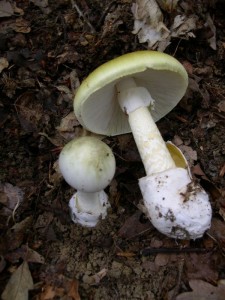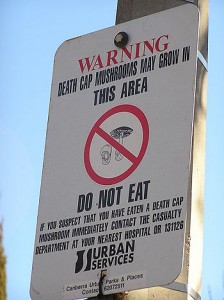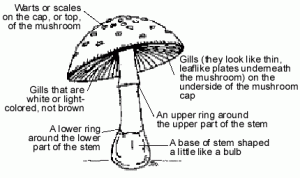 “The road to hell is paved with good intentions;” ever hear that one? No? How ’bout: Don’t eat wild vegetation indiscriminately. And another oldie but goodie: If you are a caretaker of others, do not experiment with their health. Oh yeeeeeah, timeless wisdom all; and all appropriate to this story: A third person has now died in a California nursing home, apparently the victim of an accidental poisoning from wild mushrooms.
“The road to hell is paved with good intentions;” ever hear that one? No? How ’bout: Don’t eat wild vegetation indiscriminately. And another oldie but goodie: If you are a caretaker of others, do not experiment with their health. Oh yeeeeeah, timeless wisdom all; and all appropriate to this story: A third person has now died in a California nursing home, apparently the victim of an accidental poisoning from wild mushrooms.
According to the California state Department of Social Services, a 90-year-old man died on Saturday at a senior care facility where a caretaker found the fungus in the backyard and used it to make soup. The Gold Age Villa in Loomis, California (near Sacramento) has reported three deaths (the others, women aged 86 and 73) from the homemade soup served on November 8, and it is being described as a terrible accident. The caretaker at the six-bed care facility did not know the mushrooms were poisonous, investigators said. The following day, those who ate the soup were ill.
The symptoms included vomiting and diarrhea–typical body responses in an attempt to expel toxic substances. Because symptoms related to mushroom toxicity can take up to 12 hours to surface, it can make it difficult to diagnose. Says Dr. Kent R. Olson, medical director of the San Francisco division of the California Poison Control System, “People don’t necessarily make a connection right away,” unlike food poisoning, which comes on much more quickly.
The main problem with mushroom poisoning is that it attacks the liver, halting normal protein production, and eventually shutting the organ down and causing death.
“Once that happens the liver can’t regenerate, so they go into a liver failure,” Olson said. “It’s quite dramatic.”
Treatment for mushroom poisoning is to give massive amounts of IV fluids to prevent kidney failure, and activated charcoal to absorb the poison. In the past, the mortality rate was as high as 90% worldwide. But with the supportive care, Olson said it has declined in recent years to about 15%. This depends on proper diagnosis, and, of course, time.
In Northern California, it’s the season for wild chanterelle mushrooms (a highly sought-after variety) and for the amanita species of mushrooms that include what are known as “death cap” and “death angel” varieties–probably something to know if one is going to prepare foraged food.* Young poisonous North American amanitas often look like an edible version of a wild mushroom popular in Asia. Olson said they grow in large numbers in the San Francisco Bay area around Sacramento and in the Sierra foothills.
 Listen, this is a tragedy, and I am certain it is a common mistake. In fact, California recorded 1,700 cases of mushroom-related illnesses from 2009 to 2010, including two deaths. However, the state Department of Public Health periodically issues warnings about consumption of wild mushrooms, especially after someone eats a poisonous variety. But why not just keep things simple? Stick to foods you buy at the grocery store or farmers markets, or at the very least ones you grow yourself, but that you’ve, of course, researched and know well. Otherwise, stick to the domesticated variety.
Listen, this is a tragedy, and I am certain it is a common mistake. In fact, California recorded 1,700 cases of mushroom-related illnesses from 2009 to 2010, including two deaths. However, the state Department of Public Health periodically issues warnings about consumption of wild mushrooms, especially after someone eats a poisonous variety. But why not just keep things simple? Stick to foods you buy at the grocery store or farmers markets, or at the very least ones you grow yourself, but that you’ve, of course, researched and know well. Otherwise, stick to the domesticated variety.
Further, if you are going to experiment, then uh…you taste first…and then give it twenty-four hours. That way you won’t harm those entrusting you with their care. And finally, we all know that most of us want to do the right thing; but no need to reinvent the wheel. Just stick to the tried and true, and leave the wild mushrooms to foraging animals. Believe me, if they were edible, something would have probably gotten to it before you. Their presence alone should be warning enough.
*If you must forage, please educate yourself first: A simple Google search provided me with guide in 0.18 seconds http://www.wikihow.com/Pick-Wild-Chanterelle-Mushrooms













